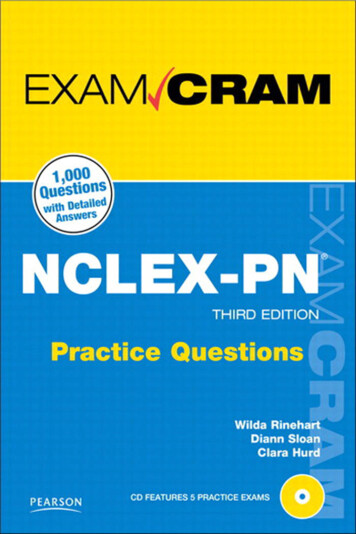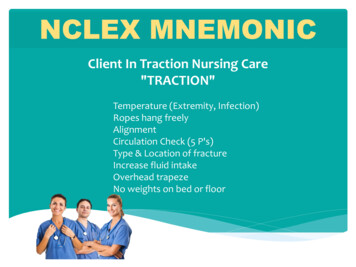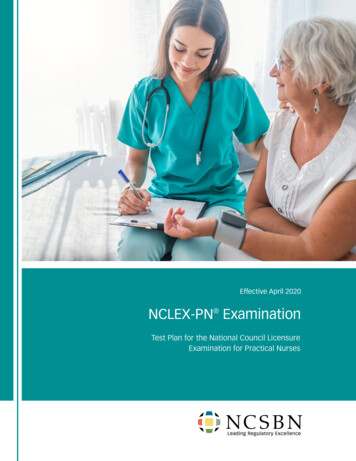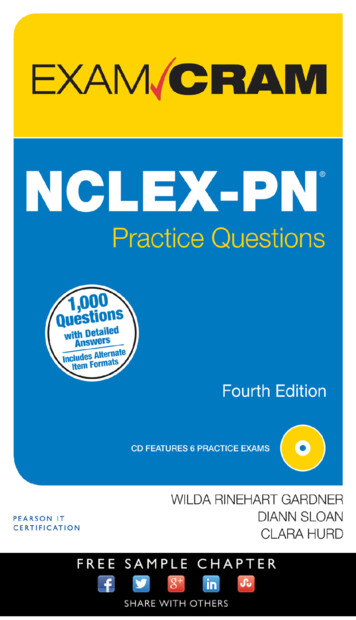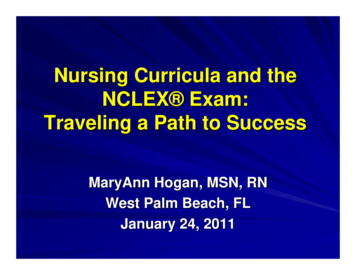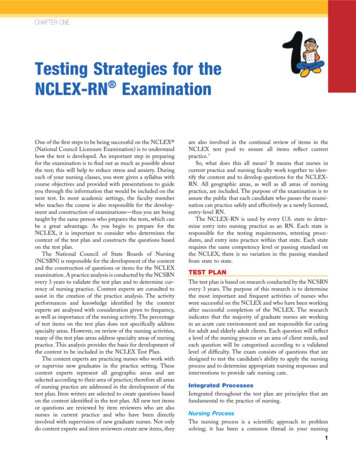
Transcription
Testing Strategies for theNCLEX-PN ExaminationOne of the first steps to be being successful on the NCLEX (National Council Licensure Examination) for practical nursing is to understand how the test is developed. An importantstep in preparing for the examination is to find out as much aspossible about the test; this will help reduce stress and anxiety. During school there were course objectives and facultyclass presentations to guide you through the information thatwould be included on the next examination. In most academicsettings, the nursing faculty responsible for teaching a coursewas also responsible for the development and constructionof the course examinations. As you begin to prepare for theNCLEX-PN, it is important to consider who determines thecontent of the test plan and constructs the questions based onthe test plan.The term practical nurse (PN) is used in this text. There areseveral states that refer to the practical nurse as a licensed vocational nurse (LVN). There is no difference between thesetwo titles, but the National Council consistently uses the termpractical nurse.The National Council of State Boards of Nursing (NCSBN)is responsible for the development of the content and the construction of questions or items for the NCLEX -PN examination. A practice analysis is conducted by the NCSBN every 3years to validate the test plan and to determine currency ofnursing practice. Content experts are consulted to assist in thecreation of the practice analysis. The activity performancesand knowledge identified by the content experts are analyzedwith consideration given to frequency of performance, impacton client safety, and variety of client care settings. This analysis provides the basis for development of the content to be included in the NCLEX Test Plan.The content experts are practicing nurses who work with orsupervise new graduates in the practice setting. These contentexperts represent geographical areas across the United Statesand are selected according to their area of practice; thereforeall areas in the practice of practical nursing are addressed inthe development of the test plan. Item writers are selected tocreate questions based on the content identified in the test plan.Item writers are nurses currently licensed in their jurisdictionwho are responsible for supervision and teaching of practicalnursing students in the clinical area, or who are currently employed in clinical nursing practice working with new graduate practical nurses. An additional panel of practicing nursesreviews all new test items or questions to ensure that eachquestion or item reflects entry level practical nursing practice.Not only do content experts and item reviewers create newitems, they are also involved in the continual review of itemsin the NCLEX test pool to ensure all items reflect the currentpractice of practical nursing.1So, what does this all mean? It means that nurses in currentpractice and nursing faculty work together to identify the content and to develop questions for the NCLEX-PN. The purposeof the examination is to assure the public that each candidatewho passes the examination can practice safely and effectivelyas a newly licensed, entry-level PN.The NCLEX-PN is used by every U.S. state to determine entry into nursing practice as a PN. Each state is responsible forthe testing requirements, retesting procedures, and entry intopractice within that state. Each state requires the same competency level or passing standard on the NCLEX; there is novariation in the passing standard from state to state.TEST PLANThe test plan is based on research conducted by the NCSBNevery 3 years. The purpose of this research is to determine themost important and frequent activities of practical nurses whowere successful on the NCLEX and who have been workingafter successful completion of the NCLEX. The current research indicates that the majority of graduate practical nursesare working in long term care facilities or in hospitals and arecaring for clients ages 65 to over 85 years old.1 Each questionwill reflect a level of the nursing process or an area of clientneeds, and each question will be categorized according to avalidated level of difficulty. The exam consists of questionsthat are designed to test the candidate’s ability to apply thenursing process and to determine appropriate nursing responses and interventions to provide safe nursing care.Integrated ProcessesIntegrated throughout the test plan are principles that are fundamental to the practice of practical nursing.Nursing ProcessThe nursing process is a scientific approach to problem solving;it has been a common thread in your nursing curriculumsince the beginning of school. There is nothing new about thenursing process on the NCLEX. Data collection, planning,implementation and evaluation are all integral steps in the1
2CHAPTER 1NCLEX-PN Testing Strategiesnursing process. It is important to keep the steps of the nursingprocess in mind when you are critically evaluating an NCLEXquestion, data must be obtained and analyzed before an actioncan be determined. (Box 1-1)CaringThe interaction of the client and the nurse occurs in an atmosphere of mutual respect and trust. To achieve the desiredoutcome, the nurse provides hope, support, and compassionto the client.Communication and DocumentationEvents and activities—both verbal and nonverbal—that involve the client, the client’s significant others, and the healthcare team are documented in handwritten or electronic records. These records reflect quality and accountability in theprovision of client care. Principles of documentation and provision of client confidentiality are important considerations inany area of nursing practice.Teaching and LearningNurses provide or facilitate knowledge, skills, and attitudesthat promote a change in clients’ behavior through teachingand learning. Nurses provide education to clients and to theirsignificant others in a variety of settings. 2Areas of Client NeedsThe National Council Examination Committee has identifiedfour primary areas of client needs, which provide a structureto define nursing actions and competencies across all practicesettings and for all clients. These areas reflect an integratedapproach to the testing content; no predetermined number ofquestions or percentage of questions pertain to any particulararea of practice (e.g., medical-surgical, pediatric, obstetrical).Table 1-1 lists the areas of client needs, with the subcategoriesand the specific weight associated with each subcategory. Therange of percentages for each category reflects how importantthat area is on the test plan. Physiological Adaptation, BasicCare and Comfort, and Coordinated Care are the subcategories with the highest emphasis.2 When you are studying for theNCLEX, these are concepts that should be identified acrossthe scope of nursing practice. This table has been adapted andsummarized; it does not reflect the entire test plan content.The National Council Detailed Test Plan for the NCLEX-PNmay be obtained from the NCSBN, Inc. (www.ncsbn.org).New information or new practices must be established as astandard of practice across the nation before being includedon the NCLEX. Throughout this book are TESTING ALERTboxes that call your attention to areas of the test plan. Pay attention to these boxes and think about how each concept orprinciple can apply to different types of clients.BOX 1-1Key Words for Identifyingthe Nursing ProcessThe following words are often interchangeable and have thesame meaning: Assessment: collect date, determine, observe, identifyfindings, recognize changes, notice, detect, find data,gather information, describe status, assess client Planning: include goals, plan interventions, create plan,generate goals, arrange priorities and interventions,formulate short-term goal or long-term goals, prepare listof client outcomes Implementation: implement nursing interventions, offeralternatives, teach, give, administer, chart, document,explain, inform, encourage, advise, provide, prepare Evaluation: evaluate nursing care, question results,monitor findings, repeat assessment, re-establish, consideralternatives, determine changes and response, appraisefindingsAs client conditions or nursing principles are presented, theNURSING PRIORITY boxes call your attention to critical information regarding a client with a specific condition or situation being presented. NURSING PRIORITY: This is critical informationto consider in providing safe nursing care for a clientwith a specific problem.Classification of QuestionsThe majority of questions on the NCLEX are written at thelevel of application or higher level of cognitive ability. Thismeans a candidate must have the knowledge and understandconcepts to be able to apply the nursing process to the client situation presented in the question. NCLEX questions arenot fact, recall, or memory-level questions. The questions arebased on critical thinking concepts that demonstrate a candidate’s ability to make decisions and solve problems. Nurseswho have taken the NCLEX have stated that the NCLEX questions were not like any questions they had on nursing schoolexaminations; however, the nursing content and principlesneeded to determine the answer were provided in their nursing school curriculum. The questions and answers have beenthoroughly researched and validated. The standardization ofinformation is important because the NCLEX is administerednationwide to determine entry level into nursing practice. Thisensures that regional differences in nursing care will not be afactor in the exam.All questions presented to a candidate taking the NCLEX-PNhave been developed according to the NCLEX-PN Test Plan.The questions have been researched and documented as pertaining to entry-level nursing behaviors.2,3
CHAPTER 1WHAT ISCOMPUTER ADAPTIVE TESTING?Computer adaptive testing provides a method for generatingan examination according to each candidate’s ability. Eachtime a candidate answers a question, the computer then selectsthe next question based on the candidate’s answer to the previous question. The examination continues to present test itemsbased on the test plan and provides an opportunity for eachcandidate to demonstrate competency. The NCLEX-PN isgraded in a manner different from the grading of conventionalschool exams. A candidate’s score is not based on the numberof questions answered correctly, but rather on the standard ofcompetency as established by the NCSBN. A student’s competency level is calculated against the preestablished level ofcompetency.A test bank of questions is loaded into the candidate’s computer at the beginning of the examination. Different candidatesreceive different sets of questions, but all test banks containquestions that are developed according to the same test plan.TABLE 1-1NCLEX-PN Testing Strategies3For example, standard precautions are a critical element ofthe test plan. Many situations and clients can be presented totest this concept: one candidate may have a question based onstandard precautions required for a client who is postoperative,someone else, a situation with implications for a newborn, andstill someone else, a situation involving an older adult client.All the questions are different, but they are all based on thetest plan’s critical element of standard precautions.The candidate will receive new questions based on the responseto the previous question. When a question is answered correctly, the next question presented to the candidate may havea higher level of difficulty. A candidate cannot skip questionsor go back to previously answered questions. As the examination progresses, it is interactively assembled. As questions areanswered correctly, the next question is selected to test anotherarea of the test plan, and it may be at a higher level of difficulty. When a question is answered incorrectly, the computerwill select an easier question. This helps to prevent a candidatefrom being bombarded with very difficult questions and becoming increasingly frustrated. The computer will continueNCLEX-PN TEST PLAN - APRIL, 2008 - APRIL, 2011Safe, Effective Care and EnvironmentCoordinated Care (12%-18%)Management of nursing care—client care assignments, supervision, prioritizing nursing care,and delivery of safe care; maintaining continuity of care, legal and ethical practices; clientrightsSafety and Infection Control (8%-14%)Prevention of errors, accidents, and injury; proper use of restraints and safety devices; implementation of standard precautions; asepsis, ergonomics, handling hazardous materialsHealth Promotion and Maintenance (7%-13%)Aging process and expected body changes; growth and development and transitions; ante/intra/postpartum, and newborn care; techniques fordata collection (physical assessment); disease prevention; principles of learning and teaching; immunizationsPsychosocial Integrity (8%-14%)Mental health and illness concepts; crisis intervention; abuse and neglect; end-of-life care, cultural, religious and spiritual influences on health;grief and loss; therapeutic communication; changes in body image (expected and unexpected); substance abuse.Physiological IntegrityBasic Care and Comfort (11%-17%)Pharmacological and ParenteralTherapies (9%-15%)Assistive devices, elimination, mobility, nutrition, hygiene and oral hydration, comfortmeasures,Medication administration; adverse effects, expected effects and contraindicationsfor medicationsReduction of Risk Potential (10%-16%)Perform diagnostic testing; laboratory values – collect specimens, compare data to normalvalue, reinforce client teaching; perform therapeutic procedures; accurately monitor vitalsigns; monitor client for potential alteration in body systems (neuro checks, circulatory checks,prenatal complications, immobilization)Physiological Adaptation (11%-17%)Alterations in body systems (drainage devices, alterations in blood glucose,wound care, suctioning, identify symptoms of infection, complications ofpregnancy/labor/delivery/postpartum, etc); fluid and electrolyte imbalances;medical emergencies, radiation therapy; identify and intervene to unexpectedresponse to therapies (IV, bleeding, infection, etc).Adapted from the 2008 NCLEX-PN Detailed Test Plan (Item writer, item reviewer, nurse educator version), Chicago, 2008, National Councilof State Boards of Nursing.
4CHAPTER 1NCLEX-PN Testing StrategiesDecision: PassDecision: FailPassinglevel ofdifficultyPassinglevel ofdifficulty0102030405060707501020# of questionsFIGURE 1-1304050607075# of questionsPlateau to Establish Pass or Fail.to present questions that are based on the test plan and on thelevel of ability of the candidate until a level of competency hasbeen established (see Figure 1-1)3.TAKING THE NCLEX EXAMINATIONApplicationAn application must be submitted to the state board of nursingin the state in which the candidate wants to be licensed. Thecontact information for the state boards of nursing is availableon the National Council website. After the candidate’s application and registration fees have been received and approvedby the state, the candidate will receive an authorization to test(ATT) from the NCSBN. After the examination fee has beenpaid, it will not be refunded, regardless of how the candidateregistered.3 The candidate may register for the NCLEX at theNCLEX Candidate website or by regular mail or by telephone.All the contact information is listed in the ATT. The Candidate Bulletin (CB) is available on the National Council website—be sure to print this bulletin for future reference. The CBprovides critical information, including addresses and phonenumbers for registration and specific details regarding the registration process.Scheduling the ExaminationAfter a candidate has been declared eligible to take theNCLEX and has received an ATT, the candidate may schedulean examination date. A candidate must have an ATT beforethey can schedule their examination. The CB lists the phonenumber to call to schedule the examination. Once the ATT hasbeen issued, the state stipulates a period of time within whichthe candidate must take the examination. This ranges from60 to 365 days, with the average being 90 days; this periodcannot be extended. You must test within the validity datesnoted on your ATT. The ATT must be presented at the testingsite before you can be admitted to take the examination. Youare encouraged to call and schedule the appointment to takethe examination as soon as possible after receiving the ATT,even if you do not plan to take the test immediately. This willincrease the probability of getting the testing date you want.Early in the last semester, students should begin planning forwhen they want to take the examination. Students should planon taking the examination within 2-6 weeks of graduation. Ifa review course is considered, then that should be factored intothe schedule. The month after graduation is not a good timeto plan a vacation or any life-changing events. Complete theNCLEX and then move on with your life. Do not procrastinateabout scheduling the examination, the longer after graduationand review course that the examination is taken, the colder theknowledge. Take the examination when the nursing content ismost current in your mind and you are still in the testing modefrom school.3Pearson Vue is the company that provides the testing facilityand computers for the examination. A tutorial on how to usethe computer on NCLEX is available at www.vue.com/nclex/.Go to the site and review the tutorial. It should be very familiarto you when you see it on NCLEX; this same tutorial will bepresented to you at the beginning of your examination.Testing Center IdentificationPhoto identification with a signature and the ATT will be required at the testing site. The name printed on the ATT mustmatch the identification presented at the course site. Identification must be in English and cannot be expired. Acceptableforms of identification are a U.S.driver’s license, a passport,or a U.S. state-issued identification, or a U.S. military issuedidentification. At the testing site before testing, each candidatewill be digitally fingerprinted, a photo will be taken, and asignature will be required.Day of the ExaminationYou should plan on arriving at the center about 30 minutesbefore scheduled testing time. If you arrive more than 30 minutes late, the scheduled testing time will be canceled and youwill have to reapply and repay the examination fee. An erasable note board will be available at your computer terminal.You will not be allowed to take any type of books, personalbelongings, hats, coats, blank tablets, or scratch paper into the
CHAPTER 1testing area. A fingerprint scan will be required to reenter thetesting area after each break.TestingYou will have a maximum of 5 hours to complete the examination. After 2 hours of testing, you have an optional 10-minutebreak; another optional break occurs after 31/2 hours of testing.If you need a break before that time, notify one of the attendants at the testing center. The computer will automaticallysignal when a scheduled break begins. All of the break timesand the tutorial are considered part of the total 5 hours of testing time.NCLEX-PN Testing Strategies5priate state board of nursing to determine how and when yourresults will be available. Test results may be available online.In some states, results may be available within 2 to 3 days; inothers, the results will be mailed, which will require a longernotification period. Do not call the Pearson Professional Center, NCLEX Candidate Services, the National Council, or theindividual state board of nursing for test results. Follow theprocedure found in the information from the state board ofnursing where the license will be issued.3SUCCESSFUL TEST TAKING ON THENCLEX EXAMThe examination will stop when one of the following occurs:1.85 questions have been answered, and a minimum levelof competency has been established; or a lack of mini-mum competency has been established (see Figure 1-1).2.The candidate has answered the maximum number of205 questions.3.The candidate has been testing for 5 hours, regardless ofthe number of questions answered.Each candidate will receive between 85-205 questions. Thenumber of questions on the NCLEX is not indicative of thelevel of competency. The majority of candidates who completeall 205 questions will have demonstrated a level of minimumcompetency and therefore pass the NCLEX. A mouse will beused for selecting answers, so candidates should not worryabout different computer keyboard function keys. An onscreencalculator will also be available to use for math problems. Ifany problems occur with the environment or with the equipment, someone will be available to provide assistance.In each candidate’s examination, there will be 25 pretest orunscored items or questions. The statistics on these items willbe evaluated in order to determine whether the item is a validtest item to be included in future NCLEX test banks. All of theitems that are scored, or counted, on a candidate’s examination have been pretested and validated. It is impossible to determine which questions or items are scored items and whichare pretest items. It is important to treat each question as ascored item.The CB from the NCSBN is very important; read it carefullyand keep it until the results from NCLEX have been received.This bulletin will provide directions and will answer more ofyour questions regarding the NCLEX. The CB is available online (from the NCSBN at www.ncsbn.org or from Pearson Vueat www.vue.com/nclex ).TESTING ALERT: Practicing test-taking skillsis critical if you are going to be able to effectivelyuse them on the NCLEX. Practice test taking should bea component of your NCLEX preparation.Being able to effectively apply test-taking strategies on an examination is almost as important as having the basic knowledge required to answer the questions correctly. Everyone hastaken an examination only to find, on review of the exam,that questions were missed because of poor test-taking skills.Nursing education provides the graduate with a comprehensive base of knowledge; how effectively the graduate can demonstrate the use of this knowledge will be a major factor in thesuccessful completion of the examination.The NCLEX-PN is designed to evaluate a minimum level ofcompetency. The purpose of the examination is to determinewhether a candidate has the knowledge, skills, and ability required for safe and effective entry-level nursing practice asa practical nurse. Throughout the examination, questions aredescribed as being based on clinical situations common innursing; uncommon situations are not emphasized. NCLEXquestions are not fact, recall, or memory-level questions; theyare questions that require critical thinking to determine thecorrect answer. Critical thinking will require an evaluationand interpretation of client data, an understanding of the client’s condition or disease, and the ability to determine the bestaction that will most effectively meet the client’s needs.Practice testing is an excellent method of studying for theNCLEX. After taking a practice test, use the results to determine whether you need additional review in certain areas orwhether you are missing questions because of poor test-takingstrategies.Test ResultsNCLEX TEST-TAKING STRATEGIESEach examination is scored twice, once at the testing centerand again at the testing service. The test results are electronically transferred to the state boards of nursing. Test results arenot available at the testing center, from Pearson Vue, or fromthe NCSBN. Check the information received from the appro-The NCLEX questions are different from those found on nursing school exams. One of the biggest problems candidatesencounter is that there appears to be two or more correct answers. Sometimes a candidate believes that more informationis necessary to answer the question. However, the answer mustbe determined from the information provided; no one will
6CHAPTER 1NCLEX-PN Testing Strategiesclarify or provide additional information regarding a specificquestion or content. The strategies described in this sectionare critical in evaluating and successfully answering NCLEXquestions. The NCLEX Hospital: What a great place to work! In thesituations or questions presented on NCLEX, all clients arebeing cared for in an ideal environment—the NCLEX Hospital. NCLEX questions are based on textbook practices,not necessarily on the real world. It must be assumed thatclients will respond just as the textbooks indicate they will.Candidates who have a lot of clinical experience may experience problems on the test if they answer questions basedon the possibility that there may not be adequate staff orequipment or if they believe the option for the nursing carepresented is not “realistic.” Nursing care provided on theexamination is performed in the NCLEX Hospital, wherethe nurse has adequate staff, supplies, and anything elserequired to provide the safest care for the client. This approach is necessary because this is a nationally standardizedexamination. Calling the Doctor (or anyone else): Be cautious aboutpassing the responsibility for care of the client to someoneelse. This is an exam on nursing care; evaluate the questioncarefully and see what nursing action should to be takenbefore consulting or calling someone else. This includesthe RN supervisor, social worker, respiratory therapist, andhospital chaplain, as well as the doctor. After you have carefully evaluated the question, if the client’s condition is suchthat the nurse cannot do anything to resolve the problem,then calling for assistance may be the best answer. Evaluatesituations, is there a nursing action to be taken before contacting someone for assistance. A specific item on the testplan states that the nurse will identify client data that mustbe reported immediately.2 It is important to identify criticalchanges in a client’s condition, as well as make a nursingjudgment when the client’s condition requires reporting tothe RN or to the physician. Doctor's Orders: It should be assumed that a doctor’s orderis available to provide the nursing care in the options presented in the question. If the question asks for administration of a specific medication for the client’s problem, thenassume that there is an order for it. If the focus of a questionis to determine if a nursing action is a dependent or an independent nursing action, then it will be stated in the stemof the question. For example, the question may request anindependent nursing action to provide pain relief for a client. Focus on the Client: Look for answers that focus on theclient. Identify the significant or central person in the question. Most often, this is going to be the client. Wrong choices would be those that focus on maintaining hospital rulesand policies, dealing with equipment, or solving the nurse’sproblems. Evaluate the status of the client first, provide forclient safety and then deal with the equipment problems, orconcerns. Other questions may ask the nurse to respond toa client’s family or significant others. Determine the personto whom the question is directed. Client's Age: Consider a client to be an adult unless otherwise stated. If the age of a client is important to the question, it will be stated in years or in months. Descriptionssuch as “elderly adult” and “geriatric client” are not commonly used. These terms have been established as negativedescriptors of older clients. The description of such a clientmay be “older adult,” or a specific age may be given. Laboratory Values: It is important to know normal valuesfor the common laboratory tests. A question may be basedon nursing activities regarding a specific lab value, knowledge of lab values or a diagnostic procedure that wouldindicate a client’s condition is getting better or worse. Beable to identify lab values and/or diagnostic procedures thatindicate a client’s progress or lack of progress. Determinewhether specific nursing actions are required based on theabnormal values or diagnostic results. For example, whena client’s blood glucose level is 50 mg/mL and he or she isawake and alert, the client will need something to eat, preferably a complex carbohydrate. If a client has a hemoglobinvalue of 8.5 g/dL, nursing care will involve avoidance ofunnecessary physical activities, and the client will need tobe kept warm. Positions: If a specific position for the client appears in thestem of the question, then consider whether the position isfor comfort, for treatment, or to prevent a complication.Evaluate the question: What is to be accomplished by placing the client in the position, and why is the position important for this client? Sometimes a client position will appearin the options. Consider whether positioning is importantto the care of the client presented. For example, the semiFowler’s position is very important to a client who is havingdifficulty breathing, and the supine position or low Fowler’sposition may provide the most comfort for a client postoperatively. Determine the purpose of a specific client positionand then determine whether this is a priority in planning orintervention. See Appendix 3-1 for a further description ofpositions. Mathematical Computations: Mathematical computationsmay include calculations of medication dosages, conversionof units of measurement, as well as calculation of intake andoutput. You should be able to apply the appropriate formula to the situation. Some of the questions may call for twocomputations, as in a question in which all items must beconverted to one unit of measurement before a dosage iscalculated. There will be an on screen calculator, find the“calculator” button when you do the NCLEX Tutorial. Themathematical calculations may be presented in a multiplechoice format or in an alternate format question in whichyo
tent and to develop questions for the NCLEX-PN. The purpose of the examination is to assure the public that each candidate who passes the examination can practice safely and effectively as a newly licensed, entry-level PN. The NCLEX-PN is used by every U.S. state to determine en-try int


